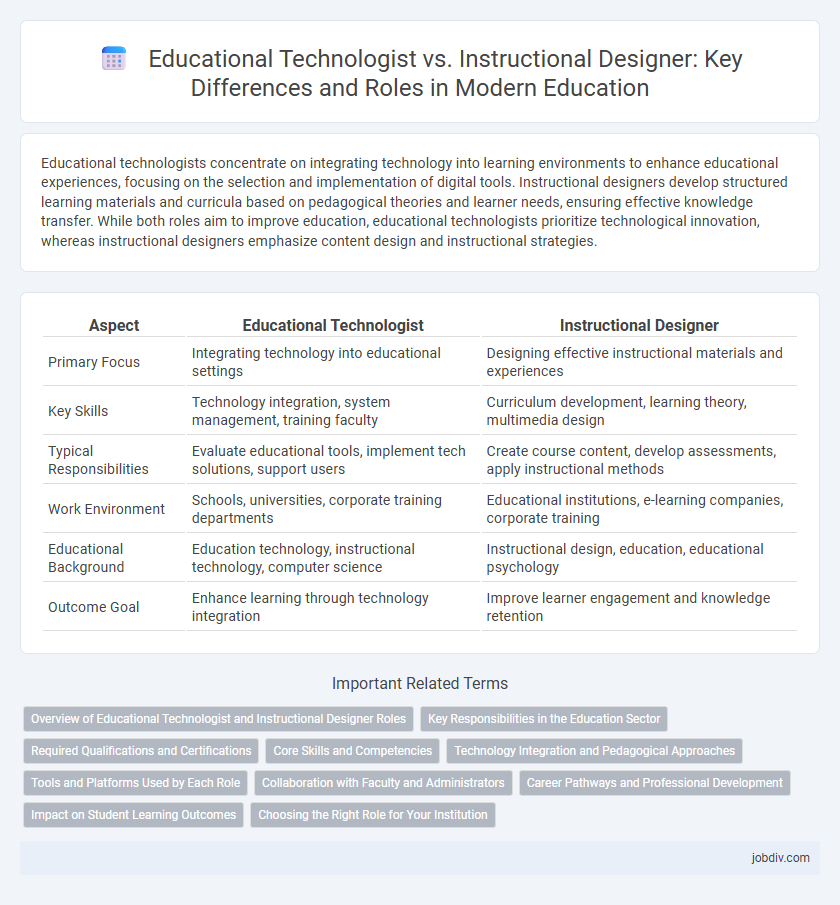Educational technologists concentrate on integrating technology into learning environments to enhance educational experiences, focusing on the selection and implementation of digital tools. Instructional designers develop structured learning materials and curricula based on pedagogical theories and learner needs, ensuring effective knowledge transfer. While both roles aim to improve education, educational technologists prioritize technological innovation, whereas instructional designers emphasize content design and instructional strategies.
Table of Comparison
| Aspect | Educational Technologist | Instructional Designer |
|---|---|---|
| Primary Focus | Integrating technology into educational settings | Designing effective instructional materials and experiences |
| Key Skills | Technology integration, system management, training faculty | Curriculum development, learning theory, multimedia design |
| Typical Responsibilities | Evaluate educational tools, implement tech solutions, support users | Create course content, develop assessments, apply instructional methods |
| Work Environment | Schools, universities, corporate training departments | Educational institutions, e-learning companies, corporate training |
| Educational Background | Education technology, instructional technology, computer science | Instructional design, education, educational psychology |
| Outcome Goal | Enhance learning through technology integration | Improve learner engagement and knowledge retention |
Overview of Educational Technologist and Instructional Designer Roles
Educational Technologists focus on integrating digital tools and emerging technologies to enhance learning environments, often collaborating with IT specialists to implement effective educational systems. Instructional Designers specialize in creating curriculum and learning experiences by applying pedagogical theories and instructional design models to develop engaging, learner-centered content. Both roles aim to improve educational outcomes but differ in their core emphasis--technologists prioritize technical infrastructure, while designers concentrate on content and pedagogy.
Key Responsibilities in the Education Sector
Educational Technologists focus on integrating emerging technologies into learning environments, ensuring that digital tools enhance educational effectiveness and accessibility. Instructional Designers develop curriculum frameworks and create structured, engaging learning materials tailored to diverse learner needs using research-based methodologies. Both roles collaborate to optimize educational outcomes, with technologists managing the technical infrastructure and designers concentrating on pedagogical strategies.
Required Qualifications and Certifications
Educational Technologists typically require a bachelor's or master's degree in educational technology, instructional design, or a related field, with certifications such as Certified Educational Technology Leader (CETL) enhancing their credentials. Instructional Designers often hold degrees in instructional design, educational psychology, or curriculum development, with certifications like ATD Certified Professional in Learning and Performance (CPLP) or Adobe Captivate Specialist being highly valued. Both roles benefit from proficiency in learning management systems (LMS) and strong knowledge of e-learning authoring tools aligned with industry standards.
Core Skills and Competencies
Educational Technologists specialize in integrating digital tools and learning management systems to enhance educational experiences, emphasizing technical proficiency and data analytics. Instructional Designers focus on curriculum development, learning theories, and assessment strategies to create effective instructional materials tailored to diverse learner needs. Both roles require strong collaboration, project management, and a deep understanding of pedagogy, yet differ in their core focus on technology implementation versus content design.
Technology Integration and Pedagogical Approaches
Educational technologists specialize in integrating cutting-edge technologies such as AI, VR, and LMS platforms to enhance learning environments, focusing on technical infrastructure and system implementation. Instructional designers emphasize pedagogical approaches by developing curriculum and learning materials tailored to cognitive theories and instructional strategies that promote effective knowledge acquisition. Both roles collaborate to ensure technology integration aligns with educational objectives and optimizes learner engagement and outcomes.
Tools and Platforms Used by Each Role
Educational Technologists primarily utilize learning management systems (LMS) such as Moodle and Blackboard, along with multimedia creation tools like Adobe Captivate and Articulate Storyline to develop and manage digital learning environments. Instructional Designers focus on authoring tools such as Lectora, Camtasia, and rise.com, emphasizing content development and curriculum structuring to optimize learner engagement and knowledge retention. Both roles integrate analytics platforms like Google Analytics and SCORM-compliant software to assess learning outcomes and improve instructional strategies.
Collaboration with Faculty and Administrators
Educational technologists collaborate closely with faculty and administrators to integrate technology effectively into curricula, ensuring that digital tools enhance learning outcomes. Instructional designers partner with these stakeholders to develop pedagogically sound course materials that align with institutional goals and student needs. Both roles require continuous communication and feedback loops to adapt strategies based on faculty expertise and administrative priorities.
Career Pathways and Professional Development
Educational technologists specialize in integrating advanced technologies to enhance learning environments, often pursuing careers in edtech companies or academic institutions focused on innovation. Instructional designers primarily create effective learning experiences and curricula, typically advancing through roles in corporate training, higher education, or e-learning development. Both career pathways offer continuous professional development through certifications such as CPTD for instructional designers and CETL for educational technologists, emphasizing skills in learning theory, technology application, and project management.
Impact on Student Learning Outcomes
Educational technologists integrate advanced digital tools and learning platforms to create immersive and interactive experiences, significantly enhancing student engagement and retention. Instructional designers focus on structuring content and assessments to align with learning objectives, ensuring clarity and effectiveness in knowledge transfer. Both roles collaboratively improve student learning outcomes by combining technology integration with pedagogical strategy, leading to personalized and efficient educational experiences.
Choosing the Right Role for Your Institution
Educational Technologists focus on integrating digital tools and innovative technologies to enhance learning environments, while Instructional Designers specialize in creating structured curricula and learning experiences based on pedagogical theories. Institutions aiming to leverage technological advancements for dynamic, interactive learning should prioritize hiring Educational Technologists. Conversely, organizations seeking to develop effective, research-based instructional materials benefit more from the expertise of Instructional Designers.
Educational Technologist vs Instructional Designer Infographic

 jobdiv.com
jobdiv.com